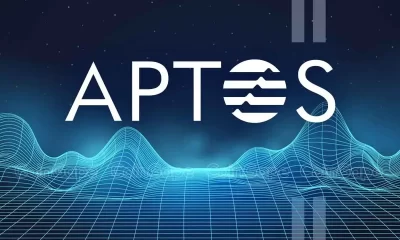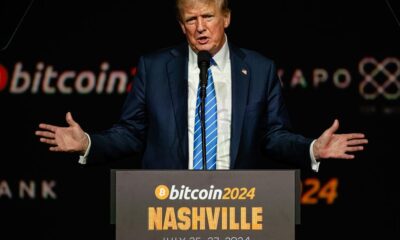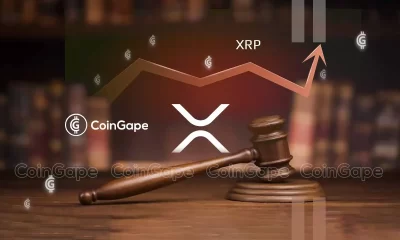Opinion
The Ethereum Foundation Has Lost Its Way
Published
2 months agoon
By
admin
The Ethereum Foundation is a paradox. Despite its commitment to decentralization, it operates as a centralized entity, with a director, a treasury, paid developers, and an inner circle. These structures, while necessary for coordination, create tensions with Ethereum’s decentralized ethos.
The Foundation Today
It is not widely known, but the current foundation was constructed in a less than ideal way. The previous director, Ming, was ousted in a coordinated effort by a group of people who have never been publicly identified or held accountable for it. I spoke with Ming days before her removal and she assured me she had no intent of leaving. I was later given information about who was responsible for her removal, but was not given much insight as to why. I have heard that Ming was a bit of a micromanager, and that she had an intensity that rubbed some people the wrong way. I’m sure there’s truth to that, but these stories are often window dressing for deeper truths.
I can infer some good-faith reasons based on the way the org has been run over the past seven years. A very important role of the organization is to protect against internal power struggles as well as external capture. These are noble goals and ones they seem to have accomplished effectively.
Another major focus seems to have been minimizing the public footprint of the organization and constructing it in such a way that it would not draw the ire of governments who might hold them accountable if the political winds shifted against them. But as political winds shift, and the marketplace provides alternatives, the organization itself must adapt, both in form and function.
Ethereum was in its birth a visionary project, not simply technological in nature. It pointed towards a possibility of previously unimaginable futures through the empowerment of the individual to do what had previously taken billions of dollars, thousands of people, or millions of man hours to accomplish.
The Ethereum Foundation, in its current incarnation, designed to minimize threats both internal and external, has lost that vision.
Lead with Vision
Ethereum’s next phase demands more than just technical research and coordinating conferences. It requires visionary leadership — someone who understands not just the technology but its broader social, philosophical, and political implications. This leader must inspire a new generation of builders, connect technology with human needs, and navigate the complexities of the political landscape without compromising Ethereum’s ethos.
Read more: Sam Kessler – Ethereum’s Vitalik Buterin Goes On Offense Amid Major Leadership Shake-up
The Ethereum whitepaper was not just a technical document; it was a beacon that allowed like-minded people to come together under a shared vision. In the face of chaos, uncertainty, and frequent conflicts, it served as a guiding light. What ensured our collective success was not the absence of challenges but the clarity of the mountaintop we were striving toward. This common vision allowed us to stay aligned even when disagreements and setbacks arose.
It was an idea whose time had come—a blueprint that transcended the individuals behind it and inspired a community to persevere, innovate, and ultimately bring that vision to life. Without it, the project could have easily unraveled under the weight of its ambition.
Be Transparent, Focus More on the Community
Transparency is equally critical. Over the past few years, the Foundation has retreated into the shadows, leaving the community feeling disconnected. But ethereum would have been nothing without its community, and it will be nothing if it loses it. A community must be managed, curated, and cared for. It requires the onboarding of new people, with new energy, and new ideas, bound by a common vision. This also includes the teams who build on ethereum.
Seize the Moment
From a legal perspective, Ethereum must embrace the opportunity to engage with lawmakers. The current American political climate is uniquely favorable, and inaction now risks losing momentum. America has elected a President who not only owns ether, but has himself launched a lending protocol on top of it. As of now, we are inhabiting a political landscape which was unthinkable even a year ago, when Democrats surprised so many of us by openly declaring war on crypto, and the future seemed uncertain. There has never been a better time than now to ensure that the promise of crypto is realized.
While maintaining political neutrality, the Foundation can create or promote frameworks that encourage compliance and innovation. Without these frameworks, the crypto space has been plagued by speculative ventures—ICOs, DAOs, NFTs—that skirt regulations rather than working within them to build sustainable use cases.
Lead by Example
The Ethereum Foundation should also consider utilizing its own technology to coordinate its operations and demonstrate the transformative potential of decentralized systems. By adopting Ethereum-based tools and protocols, the Foundation could potentially manage governance, treasury disbursements, decision-making processes, and community engagement.
This approach would not only demonstrate Ethereum’s capabilities but also reinforce trust within the community by embodying the principles of decentralization and transparency that the project champions. Additionally, leveraging Ethereum’s ecosystem for coordination could serve as a real-world case study, inspiring developers and organizations to explore similar solutions. By integrating its technology into its own operations, the Foundation would highlight the real-world utility of the platform while setting a precedent for how decentralized systems can effectively manage complex organizations.
Be Accountable, Build the Future
Finally, financial accountability must become a priority.
With $100 million spent annually, the Foundation should deliver measurable outcomes. Despite significant investment in technical research, user experience in crypto remains stagnant. Improving UX, UI, key management, and other security and usability problems isn’t insurmountable but has been severely neglected. This oversight reflects a blind spot which must be addressed before wider adoption is possible.
Ethereum began as more than just a technological project—it was a visionary movement for empowering individuals to achieve what once required massive resources. That vision is at risk of being lost. To reignite it, the Foundation must embrace transparency, invest in leadership, engage the community, and step into the legal and political spotlight.
Ethereum’s story is one of triumph over chaos, and a testament to the power of collective vision. To ensure its future, the Ethereum Foundation must transform itself from a reactive institution into a proactive visionary force. For ethereum. For the community. For the greater good. For the future.
With Love,
Texture
Source link
You may like
Bitcoin
BTCFi: From passive asset to financial powerhouse?
Published
1 day agoon
March 30, 2025By
admin
Disclosure: The views and opinions expressed here belong solely to the author and do not represent the views and opinions of crypto.news’ editorial.
Bitcoin (BTC) has always been the face of crypto, the first thing that comes to mind when you think of this market. But for years, its role has been largely static—held as a store of value, yet rarely used for anything else. Then BTCFi entered the scene: unlike traditional DeFi, which has been dominated by Ethereum (ETH) and other smart contract platforms, BTCFi is built around Bitcoin as the core asset.
In the last quarter of 2024, BTCFi’s total value saw a massive surge—from $800 million all the way to $6.5 billion. The momentum is impressive, to say the least. More institutional players are taking notice, and analysts predict that by 2030, roughly 2.3% of Bitcoin’s circulating supply (about $47 billion) could be actively used in decentralized finance.
So clearly, BTCFi is not just a passing trend. But why is it gaining so much traction? Can it really be called the future of Bitcoin’s utility as a financial asset?
Let’s try to figure it out.
What is BTCFi, and why is it growing now?
BTCFi represents the intersection of Bitcoin and decentralized finance, with the first crypto playing the role of the core asset in this case. Typically, DeFi platforms have been built on blockchains like Ethereum, while Bitcoin holders had to wrap their BTC into ERC-20 tokens (like wBTC) to participate in this field.
This kind of tokenization started picking up the pace around 2020, allowing BTC holders to access DeFi services that are typically not available on the Bitcoin blockchain. These “wrapped” tokens are built in a way that makes them compatible with other blockchain networks. And so, they effectively extended Bitcoin’s functionality.
However, advancements in Bitcoin L2 solutions and LRTs, or layered rollup technologies, are now changing the rules. It is becoming unnecessary for Bitcoin to use “second class citizen” ERC-20 tokens anymore.
BTC LRTs, for example, operate on Ethereum and other chains as well, but use Bitcoin as the primary collateral in transactions. This means unlocking the use of Bitcoin as a yield-generating asset in other networks beyond its native chain.
The emerging Bitcoin L2s, meanwhile, are tackling this blockchain’s long-standing scalability issues, allowing for faster and more cost-efficient transactions. These innovations are going to fundamentally redefine Bitcoin, turning it from a passive store of value to an actively utilized financial asset.
Why is BTCFi the gateway for Bitcoin whales in 2025?
Large Bitcoin holders—miners, in particular—have often used CeFi loans backed by their BTCs to fund their operations since they didn’t want to outright sell those assets. This practice is still going on today, but BTCFi promises to make some changes. And that’s where everything will start from, really: by BTCFi enabling new opportunities for Bitcoin holders to put their assets to work.
Soon enough, Bitcoin whales will start looking at BTCFi as a powerful gateway that can be used to enter the DeFi space. And the way I see it, there are two key factors in 2025 that will influence that perception.
The first is the rise of Bitcoin ETFs. BTC ETFs currently account for almost 6% of all Bitcoin supply, having crossed $100 billion in holdings at the beginning of 2025. With them gaining mainstream traction, Bitcoin is increasingly perceived as the safest and most stable cryptocurrency asset.
This makes it a prime choice for DeFi, attracting large-scale holders who want to use their BTC without selling. Earlier in February this year, Goldman Sachs announced that it had invested $1.63 billion in Bitcoin ETFs. That’s easy proof right there.
The second major factor is the appearance of BTC L2 technologies, which we’ve already covered earlier. Until recently, the lack of scalability and transaction efficiency held Bitcoin back from DeFi adoption. Now, we are going to see a surge of L2 solutions that will enhance the network’s performance. And here’s the important part: they will do so while preserving Bitcoin’s core principles of decentralization and simplicity (and, hence, its robustness).
What DeFi platforms need to do for proper BTCFi integration
There are several challenges that will need to be overcome before BTCFi can achieve truly seamless integration. The biggest technical issue will be ensuring that Bitcoin-based L2 solutions become genuinely trustless. At the present time, they are not quite there, often relying on intermediaries and centralized elements, which goes against Bitcoin’s core philosophy.
The good news is that there’s a lot of R&D going on to make it happen. If successful, it could make the vast amounts of BTCs that are currently just lying there “collecting dust” be useful in DeFi.
Another big challenge is going to stem from people’s trust. Among Bitcoin holders, there are many who do not quite trust Ethereum and the existing Bitcoin tokenization methods. The key to winning them over will lie in creating robust and cost-effective solutions on the native Bitcoin network. Having a fully trustless and inexpensive execution layer on the BTC blockchain could really become the dealbreaker for these people.
The future of Bitcoin: More than just ‘digital gold’
For years, Bitcoin has been carrying the moniker of “digital gold”—a safe-haven asset meant for holding rather than using. These days, this is becoming increasingly untrue. As more institutional players enter the crypto space, the potential for BTCFi to become Bitcoin’s next-level evolution is very real.
The demand is on the rise, and the infrastructure is already being built. For Bitcoin whales looking to maximize their assets without selling, BTCFi could become the perfect answer.
Disclosure: This article does not represent investment advice. The content and materials featured on this page are for educational purposes only.

Michael Egorov
Michael Egorov is a physicist, entrepreneur, and crypto maximalist who stood at the origins of DeFi creation. He is a founder of Curve Finance, a decentralized exchange designed for efficient and low-slippage trading of stablecoins. Since the inception of Curve Finance in 2020, Michael has developed all his solutions and products independently. His extensive scientific experience in physics, software engineering, and cryptography aids him in product creation. Today, Curve Finance is one of the top three DeFi exchanges regarding the total volume of funds locked in smart contracts.
Source link
Bitcoin
Why Trump’s ‘Liberation Day’ tariffs may hurt crypto’s global future
Published
3 days agoon
March 29, 2025By
admin

Donald Trump’s upcoming “Liberation Day” tariff announcement is being framed by some experts as a reset of global trade and could have negative implications for crypto.
While much of the attention is focused on the political fallout and trade disruptions, the broader consequences for digital assets, and the global frameworks that support them, deserve a closer look.
Heidi Crebo-Rediker, senior fellow at the Council on Foreign Relations, recently described on Bloomberg TV U.S. President Donald Trump’s plans as a “tearing up” of existing free trade agreements with America’s closest allies. This includes the so-called “Dirty 15”, a group of major trading partners that together make up 80% of U.S. trade.
Trump’s proposed system, built on unilateral tariffs and non-tariff barriers, represents a complete shift away from the cooperative global order that has defined the last several decades of international trade.
Why does this matter for crypto?
Crypto is inherently cross-border. Its infrastructure, users, capital flows, and regulatory frameworks depend on global alignment and relatively open markets. Any shift toward economic fragmentation risks disrupting that progress.
Crebo-Rediker notes that countries like Canada are already preparing to diversify away from the U.S., bracing for a reconfiguration of trade and investment relationships. In this new era, markets could become more closed, regulation more inconsistent, and capital controls more common.
She may agree (I don’t know), but these are all hostile conditions for crypto adoption. She also warns of a broader retreat from the multilateral frameworks that underpin both global finance and regulatory cooperation.
If America turns inward while allies look elsewhere, especially towards China, which is positioning itself as a defender of the global system – it could weaken the West’s influence over digital asset standards.
Crypto advocates have cheered Trump’s recent embrace of stablecoins and digital finance, but they should be cautious. A fragmented world, with each country pulling in a different direction on trade and tech, is not a world where crypto can thrive.
Forget about Michael Saylor’s vision of Bitcoin surpassing a $200 trillion market cap and we can only hope it can hold on to a $1 trillion valuation.
If global coordination erodes, so too might the prospects for crypto’s next wave of adoption. If so, it was a fun run. If not, I’ll be glad to admit being wrong.
Source link

The synergy of political endorsement and highly speculative assets like meme coins was always bound to be disastrous, and the recent LIBRA scandal was a clear reflection of this concern.
Crypto has come a long way over the past decade. Mainstream adoption, institutional interest, and regulatory clarity helped the industry gain increasing credibility. And meme coins also carved out an exciting niche in this sector, which reflected creativity and community engagement. Yet, political meme coins could ruin this decades-worth of progress very quickly.
A promotional post from Argentina’s president, Javier Milei, caused LIBRA investors to lose over $250 million in just hours. His endorsement sparked a buying frenzy that pushed the price from near zero to almost $5 in a matter of minutes. Insiders quickly cashed out, dumping over $107 million in tokens before the price collapsed. Argentina’s fintech chamber labeled this classic rug pull without mincing words.
The Anatomy of a Meme Coin Scam
Unfortunately, the LIBRA scandal was not an exceptional case. Bubblemap analysts traced LIBRA’s origins back to the team behind the MELANIA token and other pump-and-dump schemes. The same group launched several coins that swelled in price before crashing.
President Milei, a self-proclaimed libertarian and Bitcoin enthusiast, used his platform to share information about LIBRA. His tweet ignited a rush among investors eager to capitalize on his reputation.
It’s still staggering that influential figures have yet to understand the true impact of their statements on an industry largely driven by speculative interest. As the token’s value soared, insiders began unloading their tokens. Within hours, the coin’s market cap fell from $4.5 billion to just a fraction of that amount.
However, on-chain analysis shows that LIBRA was fundamentally designed to potentially scam investors. The founders held 70% of the token supply, which allowed them to profit massively while leaving retail investors vulnerable. When insiders cashed out, many traders lost nearly everything they had invested.
Such pump-and-dump schemes always follow the same playbook: a high-profile personality sparks investor interest, insiders pocket their profits, and the token collapses. This pattern played out with LIBRA in a textbook fashion.
Political Endorsements and Market Manipulation
Political endorsements used in these schemes add a disturbing twist to the story. Milei’s tweet did more than spread a message; it lent credibility to a high-risk asset. When a sitting president supports a project, many assume there is underlying merit. This assumption helped drive the buying frenzy around LIBRA. Similar episodes occurred in the United States with the TRUMP and MELANIA tokens. Politically-linked meme coins have morphed from mere speculative plays into tools for financial manipulation.
Galaxy Research Analyst Alex Thorn describes LIBRA as the latest example of a series of Solana-based meme coin implosions. During this crash, Solana’s transaction volumes plummeted to mid-2024 levels, and there is growing concern over a $1.5 billion FTX token unlock. These factors combine to put additional pressure on Solana’s price.
Meme coins, which dominated headlines in 2024, now face harsh market realities in 2025. Many of these tokens have already lost 30-60% of their value. Activity on platforms such as Pump.fun has cratered, and overall trading volume in the sector is in freefall.
The trend of politically-endorsed tokens creates an environment where hype easily overrides fundamentals. Political figures lend their names to projects with little oversight. This practice allows groups of insiders to generate large profits at the expense of everyday investors.
The situation exposes a troubling trend in crypto markets. When prominent figures use their influence to spark buying frenzies, they turn volatile tokens into weapons for financial manipulation. Such practices risk undermining trust in the entire crypto ecosystem.
A Much-Needed End to the Chaotic Meme Coin Cycle?
The $LIBRA debacle should serve as a harsh lesson for retail investors. Many of those who lost money had a high level of technical knowledge, as they needed Solana wallets and SOL tokens to participate.
However, the overall appeal of politically charged tokens often attracts investors who believe that an endorsement from a political heavyweight guarantees success. Reality proved otherwise. When high-profile insiders exploit their inside knowledge to exit early, the outcome is disastrous for retail participants.
As institutional investors shift their focus to more stable markets like Bitcoin and Ethereum ETFs, the appetite for meme coins might be waning. Political meme coins remain the lawless frontier of crypto. Their volatile nature and inherent manipulation make them a poor choice for risk-averse investors. The recent fallout suggests that market excitement has finally run far ahead of sound fundamentals.
Political meme coins represent a clear symptom of a larger problem. They expose vulnerabilities in a market that still lacks a solid regulatory framework. When the excitement around a meme coin overshadows careful analysis, the consequences can be severe. Investors may see short-term gains, but the inevitable collapse brings long-term damage. The case of $LIBRA proves that political endorsements do not safeguard against market manipulation.
Source link

‘Positive But Cautious’ Investors Pour Capital Into Ethereum, Solana, XRP and Sui: CoinShares

Bitcoin As The Global Denominator Of Capital

Trump’s Crypto Dealings Are Making Regulation ‘More Complicated’: House Financial Services Chair

Pontus-X taps Oasis for private, cross-border data sharing in E.U.

Elon Musk, Dogecoin Proponent and U.S. Agency Figurehead, Says ‘No DOGE in D.O.G.E.’

Crypto Investor’s Brave Yet Hilarious Prediction Speculates If XRP Price Will Hit $3,000 This Cycle

Dogecoin (DOGE) Bulls In Trouble—Can They Prevent a Drop Below $0.15?

California introduces ’Bitcoin rights’ in amended digital assets bill

MELANIA Insider Hayden Davis Selling Millions of Dollars Worth of Memecoin Amid 95% Drop: On-Chain Data

Toulouse starts to accept crypto for public transport

Bitcoin, Crypto Prices Slide as Trade Tensions, Inflation Risks Rattle Markets

Will BlackRock Investors Stay Bullish?

Bitcoin Could Appear on 25% of S&P 500 Balance Sheets by 2030, Analyst Says

Centralization and the dark side of asset tokenization — MEXC exec

Bitcoin Support Thins Below $78,000 As Cost Basis Clusters Shift Toward $95,000

Arthur Hayes, Murad’s Prediction For Meme Coins, AI & DeFi Coins For 2025

Expert Sees Bitcoin Dipping To $50K While Bullish Signs Persist

Aptos Leverages Chainlink To Enhance Scalability and Data Access

Bitcoin Could Rally to $80,000 on the Eve of US Elections

Sonic Now ‘Golden Standard’ of Layer-2s After Scaling Transactions to 16,000+ per Second, Says Andre Cronje

Institutional Investors Go All In on Crypto as 57% Plan to Boost Allocations as Bull Run Heats Up, Sygnum Survey Reveals

Crypto’s Big Trump Gamble Is Risky

Ripple-SEC Case Ends, But These 3 Rivals Could Jump 500x

Has The Bitcoin Price Already Peaked?

A16z-backed Espresso announces mainnet launch of core product

Xmas Altcoin Rally Insights by BNM Agent I

Blockchain groups challenge new broker reporting rule

The Future of Bitcoin: Scaling, Institutional Adoption, and Strategic Reserves with Rich Rines

Trump’s Coin Is About As Revolutionary As OneCoin

Is $200,000 a Realistic Bitcoin Price Target for This Cycle?
Trending

 24/7 Cryptocurrency News5 months ago
24/7 Cryptocurrency News5 months agoArthur Hayes, Murad’s Prediction For Meme Coins, AI & DeFi Coins For 2025

 Bitcoin2 months ago
Bitcoin2 months agoExpert Sees Bitcoin Dipping To $50K While Bullish Signs Persist

 24/7 Cryptocurrency News3 months ago
24/7 Cryptocurrency News3 months agoAptos Leverages Chainlink To Enhance Scalability and Data Access

 Bitcoin5 months ago
Bitcoin5 months agoBitcoin Could Rally to $80,000 on the Eve of US Elections

 Altcoins2 months ago
Altcoins2 months agoSonic Now ‘Golden Standard’ of Layer-2s After Scaling Transactions to 16,000+ per Second, Says Andre Cronje

 Bitcoin5 months ago
Bitcoin5 months agoInstitutional Investors Go All In on Crypto as 57% Plan to Boost Allocations as Bull Run Heats Up, Sygnum Survey Reveals

 Opinion5 months ago
Opinion5 months agoCrypto’s Big Trump Gamble Is Risky

 Price analysis5 months ago
Price analysis5 months agoRipple-SEC Case Ends, But These 3 Rivals Could Jump 500x


